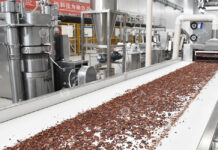
Since the collapse of global oil prices at the international market which plunged the Nigerian economy into a 25-year-low in 2016, there has been a renewed focus on the agricultural sector as the country attempts to diversify its economy away from oil.
Agriculture, which was neglected, became an option for diversification owing to its vast potentials that can drive a more sustainable economic growth in Africa’s most populous nation in terms of job creation and revenue diversification.
As a result, the government devoted a lot of energy to deepening agriculture with initiatives such as the Anchor Borrowers Programme (ABP), placing a ban on importation of some agro commodities and shutting down the borders, for the attainment of self-sufficiency in the production of major crops.
The administration also increased allocation to the sector as trend of budgetary allocation for the agriculture sector over the last few years shows that the allocation to agriculture, as a percentage of the overall annual budget to all sectors increased from 1.25 percent in 2016 to 1.82 percent in 2017 and 2.23 percent in 2018.
However, the allocation to the sector as a percentage of the overall budget declined in 2019 by 1.56percent.
But the government has failed to address some of the fundamental problems that are inherent in its quest for diversification. Some of which are;
Infrastructural gaps
One of the greatest problems confronting rural farmers and communities in Nigeria is the absence of critical infrastructure such as ‘motorable’ roads.
Nigeria continues to suffer low levels of agricultural productivity due to infrastructural deficit across the country. Due to the deplorable state of roads, farmers have to grow only what they can eat or the extra they can carry on their heads to nearby markets.
Most times, the surplus gets rotten in storage in the villages or during transit as a result of many hours or days spent in transporting the foodstuffs to where they are needed due to bad roads.
Meanwhile, urban dwellers have to spend a very large percentage of their income to buy food. This is because the food that gets to the towns and cities are far more expensive than what the poor struggling farmers would have sold them.
The high prices of these commodities are blamed on the middlemen but they are also quick to point out that they incur huge costs transporting the food as a result of bad roads.
“The roads are bad; it takes me two to three days to transport my yam produce from Benue (located in the middle belt, of Nigeria) to Lagos (located in Southwest). I lost more than 300 tubers of yam on my last trip to Mile Twelve market in Lagos because the trailer got spoilt on the road and my yam produce was stolen since the trailer slept on the road for a night,” according to Godwin Apak a yam farmer in Benue state.
“There are times our yams get spoilt on the road; the sun will burn part of it even before we get to Lagos. This usually makes me sell cheaper than I was supposed to sell. If the roads were better, the goods will get to the market on time for me to sell without it getting spoilt” Apak said.
Herdsmen attacks/Kidnapping
Apart from the impact of Boko Haram in the North-East, which has displaced thousands of agrarian communities, farming activities have also come under threat in the middle belt region and other regions in Nigeria due to conflicts between farmers and herdsmen.
This was evident in the country’s 2019 second-quarter GDP as the sector’s growth slowed.
“The crisis has implication for the agricultural sector and employment generation. It is a major risk to the growth of the sector,” said Muda Yusuf, director-general, Lagos Chamber of Commerce and Industry.
“This is also a threat to raw materials for industries. The agric sector provides the raw materials that feed on industries especially the food and beverage industries. This conflict is happening in a period of FX shortage,” said Yusuf.
Low yields per hectare
Despite growing concerns over food security and a food import bill that gulps $5 billion annually, Nigeria has failed to make appreciable efforts in increasing its farm yields, as Africa’s most populous nation still records the lowest yields per hectare amongst its peers.
Data from the Food and Agricultural Organisation (FAO) shows that Nigeria has the least average yield per hectare of five selected crops, among its African peers like Ghana, Kenya, South Africa, and Ethiopia.
For tomatoes, the average yield per hectare in Nigeria is 7 metric tons (MT), Kenya’s average yield for the crop is 20MT, Ghana tomato yield is 8.6MT and South Africa’s average yield for the crop is 86.8MT.
Similarly, for maize, which is the most consumed grain on the continent, Nigeria, Kenya and Ghana have the same average yield of 2MT per hectare, while Ethiopia’s average yield for the crop is 3.8MT per hectare and South Africa’s average yield is 6MT per hectare.
Also, for groundnut, which is widely grown on the continent, Nigeria’s average yield for the crop is 1.2MT, Ghana groundnut average yield is 1.4MT, South Africa is 1.6MT, Kenya’s average yield is 1.8MT and Ethiopia with the highest average groundnut yield among countries compared to 2.4MT.
For potatoes, which is the most well rounded and nutrient root in all of Africa, Nigeria’s yield per hectare for the crop is 3.7MT, Ethiopia potatoes average yield is 15.1MT, Kenya average is 15.5MT and South Africa average yield for the crop is 38.8MT.
Nigeria’s average yield per hectare for soybeans is 1.1MT, Ethiopia’s soybean average yield is 2.3MT, Kenya average is 1.6MT and South Africa’s average is 2.1MT per hectare.
Low use of technology
Low level of agricultural mechanisation on farms across the country has continued to limit the capacity of farmers to expand their cultivation areas, perform timely farming operations and achieve economies of scale in food production.
Available statistics show that Nigeria is one of the least mechanised farming countries in the world with the country’s tractor density put at 0.27 hp/ hectare which is far below the Food and Agriculture Organisation (FAO)’s 1.5hp/hectare recommended tractor density.
With the continual drift of the young population from the rural to urban centres in search of white-collar jobs and away from the drudgery of manual farm labour, self-sufficiency in food production is becoming a herculean task.
“Currently, more than 70 percent of farm labour is provided by human power; over 20 percent is provided with draft animal power and less than 10 percent by mechanical power,” Elesa Yakubu, national president, Tractor Owners and Operators Association of Nigeria (TOOAN), told BusinessDay.
In Nigeria, a significantly higher proportion of the farming area is still cultivated by hand tools. The International Food Policy Research Institute (IFPRI) reckons that Nigeria is still at the early stage of agricultural mechanisation. But experts acknowledge that mechanisation of power-intensive operations have been slow.
When measured in 2003, 12 years ago, Nigeria had only 30,000 tractors. Africa’s largest economy is currently adding 1,000 new ones each year, which is still not considered sufficient in replacing the aging, worn out, and broken down ones.
This means on a per capita basis, Nigeria ranks 132nd out of the 188 countries worldwide measured by FAO / United Nations in terms of the number of tractors in the country. Nigeria has fewer tractors than minnow countries like Serbia & Montenegro, with 400,000, Pakistan with 320,000, or Uzbekistan with 170,000 tractors.
Way out
For agriculture to effectively diversify the Nigerian economy from oil, the government must address the fundamental issues hindering productivity, experts say.
Experts noted that the country must increase its mechanisation scale to meet the ever-increasing population needed to be fed before the country can talk about earning foreign exchange through the sector.
They added that the government must provide the needed infrastructures such as motorable roads, effective and efficient rail transportation linking where the food are produced in the north and markets in the south as well as irrigation facilities to aid all-year farming.
Rotimi Fashola, senior partner, OIT Fash Consults, told BusinessDay that agriculture can only diversify the economy when there is higher productivity and investments.
“Until there is an aggressive increase in production, we would not see the effect yet. This will require us to do a lot more in terms of increasing productivity per unit area and increasing our land areas. We must increase our yield per hectare, which means we must use more fertilisers than we are now. It means we must increase our tractorisation, it means we must increase our water management system and introduce more irrigation,” Fashola said.
Source: Businessday Nigeria























